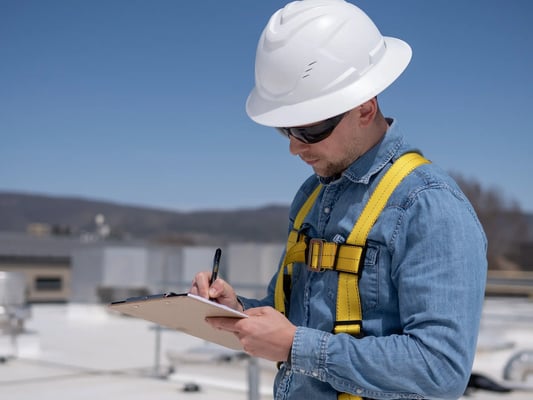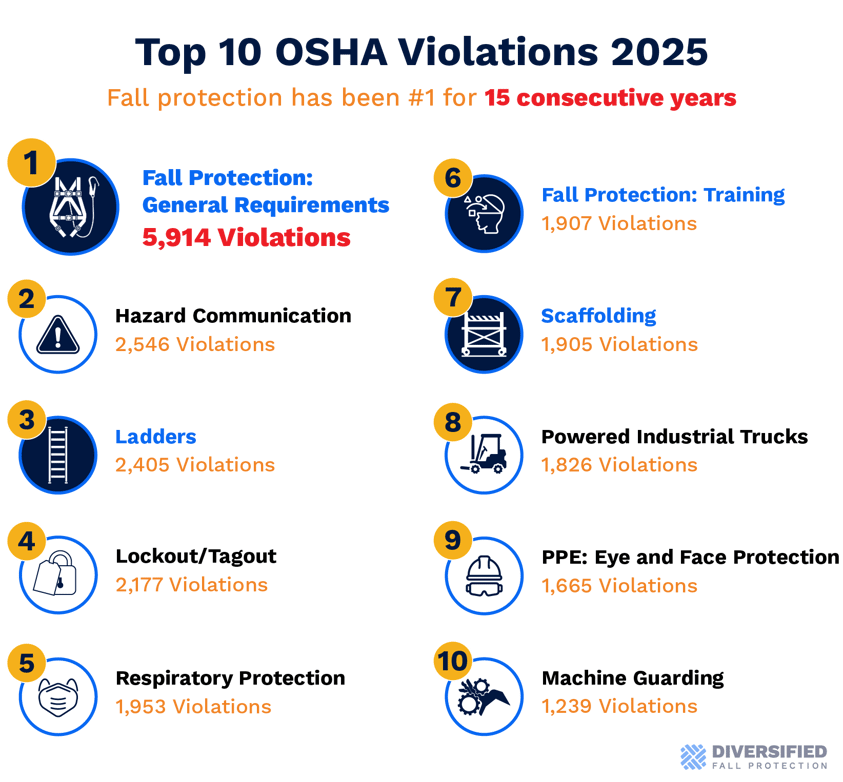
You Hate to See It: 15 Years of Fall Protection Violations at #1
OSHA recently unveiled the top 10 most cited violations for 2025 and Fall Protection remains the leading violation.
Color us surprised.
Every year, OSHA provides an updated list of the most frequently cited violations for the fiscal year, offering businesses valuable insights into areas where proactive improvements can help prevent penalties or, more importantly, worker injury and fatalities. 2025 is the 15th consecutive year fall protection has topped the list. Again, just as in previous years, 4 of the top 10 violations are related to safety at height. These 10 hazards were also the Top 10 hazards from last year, with only a few order changes.
Below is the full list provided by OSHA, with violations related to fall protection highlighted:

Top 10 OSHA Violations 2025 –
- Fall Protection—standard 1926.501, with 5,914 total violations. The industry that led violations was roofing, followed by framers and siding contractors.
- Hazard Communication—standard 1910.1200, with 2,546 total violations. Industries that led was surprisingly roofers.
- Ladders—standard 1926.1053, with 2,405 total violations. The leading industry for violations of this was roofing, followed by framers, siding contractors and residential construction.
- Control of Hazardous Energy (Lockout/Tagout)—standard 1910.147, with 2,177 total violations. The leading industry being cited for violations of this standard was the plastic products manufacturers, followed by machine shops.
- Respiratory Protection—standard 1910.134, with 1,953 total violations. The number one cause of violations was failing to provide medical evaluation for workers who are wearing respiratory protection.
- Fall Protection-Training Requirements—standard 1926.503, with 1,907 total violations. Roofing was the leading industry for violations with the number one reason being failure to provide any training at all.
- Scaffolding—standard 1926.451, with 1,905 total violations. The most frequently cited industries were masonry, roofing, framing, and siding.
- Powered Industrial Trucks—standard 1910.178, with 1,826 total violations. The leading part of the standard that led to violations not ensuring workers were trained to operate power industrial trucks.
- Personal Protective and Lifesaving Equipment—eye and Face Protection—standard 1926.102, with 1,665 total violations. The roofing industry led violations of this standard, with the no. 1 reason being not providing eye and face protection at all.
- Machine Guarding—standard 1910.212, with 1,239 total violations; the leading violations being guarding the machine at the point of operation.
Overall, 2025 resulted in a lower volume of violations cited than in 2024, but it is difficult to conclude that fewer citations equates to safer workplaces. There has been a 17% increase in fatal falls in the workplace over the past three decades, with 2021-2023 reporting an increase in fatalities each year. It’s more than likely that fewer citations given is due to the recent budget cuts and major reorganization done to OSHA, NIOSH, and the DOL.
It is also worth noting that roofers specifically were mentioned multiple times during the Top 10 reveal for being the leading industry in fall protection & other safety violations. And many citations (like Fall Protection Training Requirements) were not given to employers that simply needed to improve existing programs, but mostly to companies that simply had no training program in place! If you need assistance with ensuring your workers have proper training, Diversified Fall Protection can help, conducting training on site for minimum impact to your work schedule.
Fall protection general requirements alone accounted for nearly a quarter of all violations cited from the list. And amazingly (not in a good way), the four fall protection categories accounted for 51% of the Top 10 Violations cited. If you are an organization that has struggled to comply with OSHA minimum requirements, you’re not alone!
Understanding fall protection regulations can be complex, but one aspect is clear: the legal responsibility to protect workers rests with employers and building owners. When a preventable accident occurs, building owners are liable, and the legal consequences often greatly outweigh OSHA fines.
It is crucial for companies committed to safety to partner with fall protection experts who can ensure compliance and worker protection. Diversified Fall Protection offers turn-key solutions, including system design, engineering, installation, certification, inspections, and training. As a trusted partner, we provide consistent, dependable service across the country and take on the liability for the systems we install and inspect, offering our clients peace of mind.
If you have questions about OSHA’s most frequent citations or are looking to bring your site into compliance, please reach out to us. We’re here to help keep your workers safe.
Schedule an assessment with Diversified Fall Protection
Contact Us to request a fall safety review

b-1.jpg?width=1368&height=1340&name=Rail%20(175)b-1.jpg)

